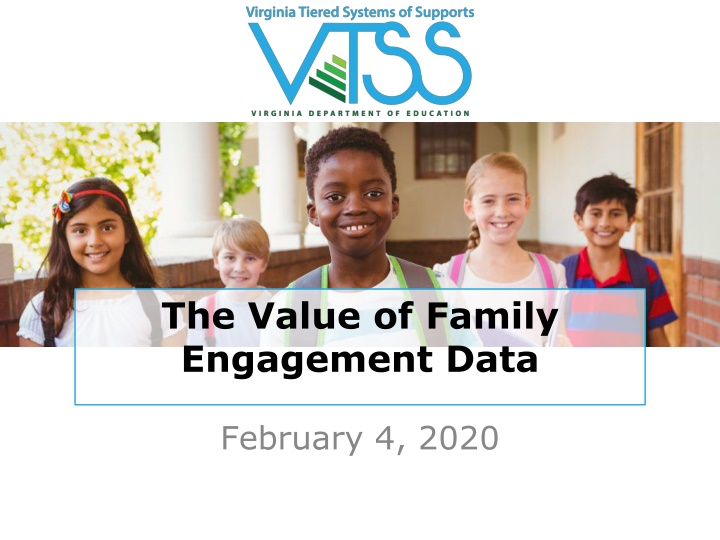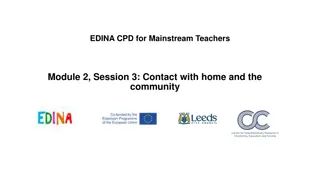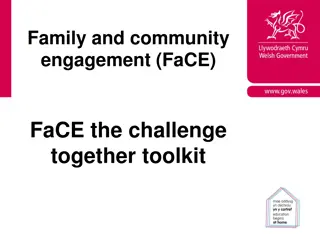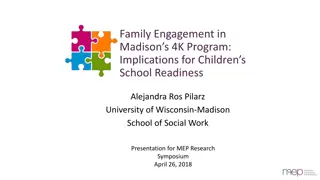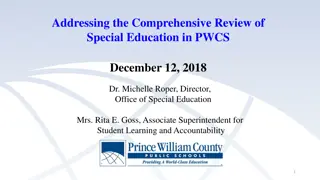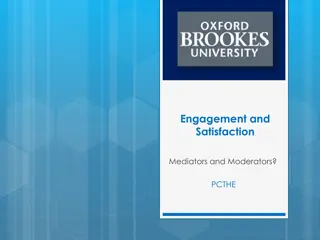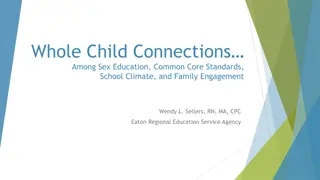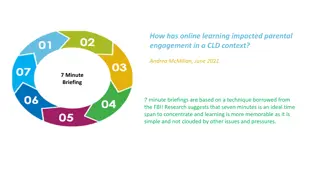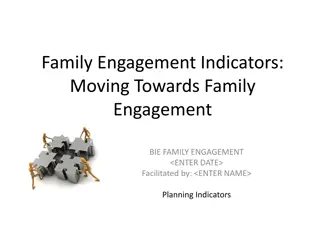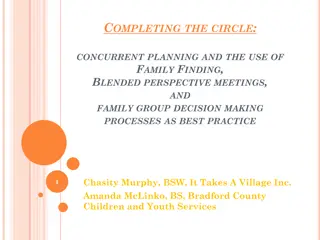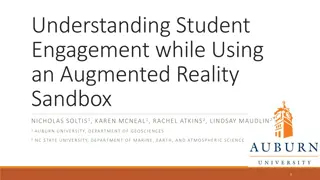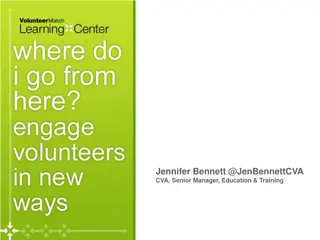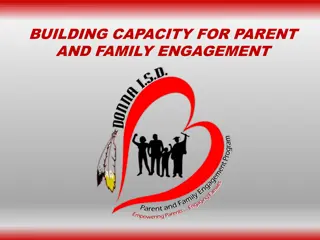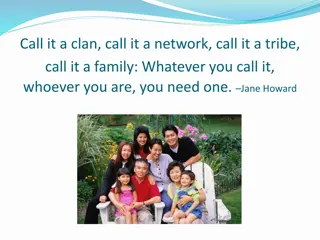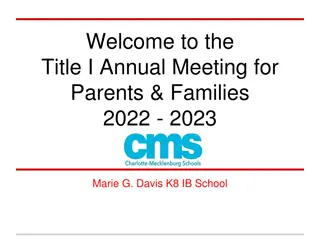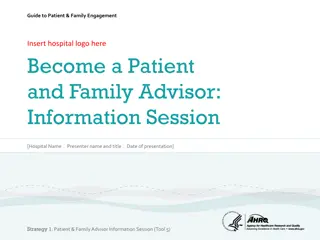Importance of Family Engagement Data in Education
This content discusses the significance of collecting family engagement data in education, emphasizing the value of positive relationships, family empowerment, leadership involvement, and collaborative problem-solving. It highlights the six components of effective family engagement and the importance of using data to monitor progress, ensure fidelity, and make a positive impact on students and families.
Download Presentation

Please find below an Image/Link to download the presentation.
The content on the website is provided AS IS for your information and personal use only. It may not be sold, licensed, or shared on other websites without obtaining consent from the author.If you encounter any issues during the download, it is possible that the publisher has removed the file from their server.
You are allowed to download the files provided on this website for personal or commercial use, subject to the condition that they are used lawfully. All files are the property of their respective owners.
The content on the website is provided AS IS for your information and personal use only. It may not be sold, licensed, or shared on other websites without obtaining consent from the author.
E N D
Presentation Transcript
The Value of Family Engagement Data February 4, 2020
Learning Intentions Understand the importance of, and value in, collecting family engagement data Stories from two Virginia divisions
A bit of levity! Imagine a cartoon with a student and teacher before a chalkboard and the student says: Before I write my name on the board, I ll need to know how you re planning to use the data.
Six Family Engagement Components Positive Relationships- educators recognize families needs and cultural characteristics, leading to greater understand and respect among all Family Empowerment- educators use effective strategies to identify and encourage families knowledge, skills and efficacy for supporting students learning From Devon Minch et al., 2017
Family Engagement Components (cont.) Leadership- Family Engagement is included in professional development, school vision, mission, and goals and are aligned with division vision and goals for engagement Multi-tiered Approach- multidimensional approaches are used to engage families in dialogue through multiple communication modes. Use of different approaches to engage families whose children are at different tiers
Six Components (cont.) Data-based Goals & Outcomes- goals and outcomes are identified based on student outcome data and input from families and staff Collaborative Problem-Solving- families of children receiving Tier 2 and Tier 3 supports are effectively engaged in all steps of the problem- solving process
Dual Capacity Framework Please contact your VTSS Systems Coach for a copy of the Dual Capacity Framework diagram from Karen Mapp with The Harvard Graduate School of Education.
Why do we collect Family Engagement data? Progress Monitoring: Did we do what we said we would do? Did we do it with fidelity? Are we making progress? What positive impact are we having for students and families? Data allows us to understand need, identify areas for improvement, and develop meaningful action plans!
You are familiar with data in your division: Division Data Graduation rates Suspensions Attendance SOLs Referrals to Special Educ. English Language Learner Percentage of students in AP classes School Data Office Discipline Referrals In School Suspension Out of School Suspension Universal screening Benchmark data SOLs Formative assessment
What data do you have for Family Engagement? VDOE s School Climate data for students and faculty. Is this data disaggregated by identity groups (e.g. race/ethnicity, gender, sexual orientation, religion, etc.)? Family input surveys - Which families responded?
Examples of Family Engagement Data # of signed Daily Progress Reports into a Family Raffle per month # of parents at parent/teacher conferences # of returned Home Incentive Plans # of those students that we made individualized contact home for Home Incentive Plan that resulted in ongoing communication Tracking all of this information over time!
What data do you wish you had? Family engagement initiatives: What did you do? Which families were involved? Which families were not involved and WHY? Was the initiative successful? What data informs this? What would you do differently next time?
Poll Questions Do you have a family survey? Do you share the results from the survey with families?
Date Night with Data October 29th at 5:30 p.m. Annual Title I Informational Meeting Come and find out about all of the great resources and services available for the families and students at Kiptopeke Elementary School offered through the Title I Program. Dinner will be served! 14
Family Data Notebook Includes Family Goal Statements Please see your VTSS Systems Coach for a copy of this form. 15
STAR Reading & Math STAR Reading is a test of reading comprehension and skills for independent readers. Parent Reports are available. 16
VKRP VKRP is a screening tool that assists teachers in providing differentiated mathematics instruction for all students. Untimed assessments measure the following skills: Geometry (recognizing shapes) Patterning (creating and extending patterns) Numeracy (counting, number sense) Computation (solve story problems) 17
PRE-K BIG DAY The Pre-K Big Day assessments are directly related to our new curriculum. We assess your child s social emotional development in four areas (self awareness, self-regulation, social competence, and social awareness) We assess your child s mathematics skills in four areas (number sense, geometry, sorting, and patterns) The letter score is either P (pre-emergent), B (beginning), E (emerging), or D (developed) 18
Feedback from Families Thank you so much for having Date night with Data. The information that was given was very helpful and informative. I know where my kids stand not only on a school level but also the National level. Thanks again for a great Date Night with Data. 6thGrade Parent 19
Decision Making Using Family Engagement Data 1 LUNENBURG COUNTY PUBLIC SCHOOLS Meri Page Spencer, Family Engagement & Public Relations Coordinator meredith.spencer@k12lcps.org
Data Collection 2 Parent Event Sign In Data LCPS Elementary Parent Survey
How do we use this Data to Make Decisions? 3 Review Information with our Parent Advisory Committee
Two Items that the Data Demonstrates-- 4 1. From Review of Parent Event Sign In Data - HISPANIC POPULATION AT KES ATTENDS ONSITE EVENTS BETTER THAN OFFSITE EVENTS 2. From LCPS Elementary Parent Survey 3. PARENTS WANT TO BE COMMUNICATED WITH MOST BY TEXT MESSAGE 1. From Parent Event Sign In Data HISPANIC POPULATION AT KES ATTENDS ONSITE EVENTS BETTER THAN OFFSITE EVENTS
Ideas Noted Brainstorming Data with Parent Advisory Committee 6 1. Hispanic Event Attendance Issue-- Have the park event at the Kenbridge Park in the fall to see if that makes a difference Make absolutely sure that a local interpreter is always present at our off-site events Ideas for new questions on our LCPS Parent survey for division level will be brought to March Meeting along with questions for a possible survey of just our Hispanic population.
Ideas Noted Brainstorming Data with Parent Advisory Committee 2 6 1. Hispanic Event Attendance Issue-- (continued from last slide) We utilize new student and parent council at KES to add Hispanic members to the PAC aim to have new members present at March Meeting
2. Parent Communication Wishes-- 7 A Committee member had spoken to Hispanic parents and found out that the text messages that we send work well for them. They can copy and translate it or simply show it to their child to translate on the spot. First year that Flyer in the Backpack option was NOT number 1. Will send more text messages with our Alert System.
Next Steps 8 More discussion with items mentioned earlier brought to and decided on at our March Meeting. Administration will be informed of decisions made for change. Changes will be implemented for our events and surveys for next school year over the summer.
Change to Increase Effectiveness of Parent Event Sign In Data Collection & Analysis I have now been trained and given administrative rights for Performance Matters which is a testing platform that communicates with PowerSchool, our SIS system. As a side effect if you will, it has a dynamic way of being able to show and analyze data. With assistance from our Director of Data Analysis and our Director of Instruction & Curriculum, we have developed a way to download spreadsheets that can be used for parent sign in while maintaining confidentiality. Then we can use those spreadsheets to sort data, create charts, and quickly analyze data from each parent event. We will start this process with our next parent event this Spring. 9
How do you use your data? What is your outcome? Recall the VTSS Implementation Logic
Next Virtual Community of Practice April 14, 2020, 3:30 Family Engagement and the Administrators' Role
